Nokia Lumia 930 Review
by Brett Howse on September 8, 2014 3:00 PM EST- Posted in
- Smartphones
- Microsoft
- Nokia
- Mobile
- windows phone
- Lumia
CPU Performance
The Lumia 930 is the second device from Nokia to utilize the Snapdragon 800 platform, with the Lumia 1520 6” Phablet also sporting the same SoC. In this particular case, it is the MSM8974VV variant which contains four Krait 400 cores at up to 2.2 GHz, along with as Adreno 330 GPU. The 930 also has 2 GB of LPDDR3 memory. This combination really kick-starts Windows Phone, which prior to the 1520 had been utilizing dual-core Krait 200 on the upper end models. The implications are dramatic, with the Lumia 930 providing a huge real-world increase in speed. Anyone who believes Windows Phone somehow does not need a faster SoC is kidding themselves, as this device has proven to me. App loading times are much quicker, and app rehydration, which is a huge issue on older devices, is so much quicker that it is almost instant. Skype is well known to all Windows Phone users for having sometimes ridiculous rehydration times, but the Snapdragon 800 almost completely overcomes this handicap.
We can use several benchmarking tools in order to quantify this difference in performance. We will start with some web based javascript tests, and then move on to some native benchmarking tools.
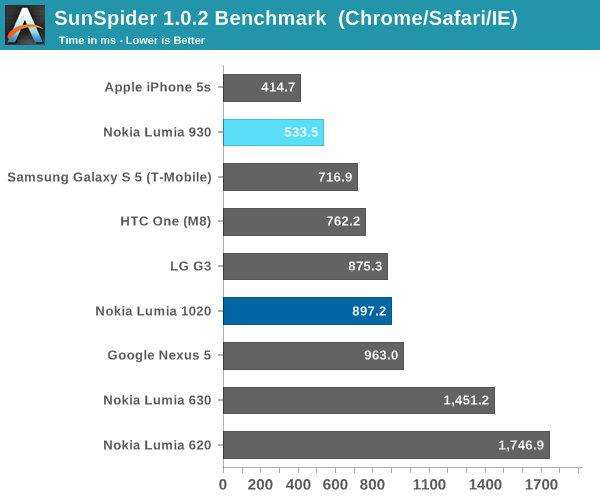
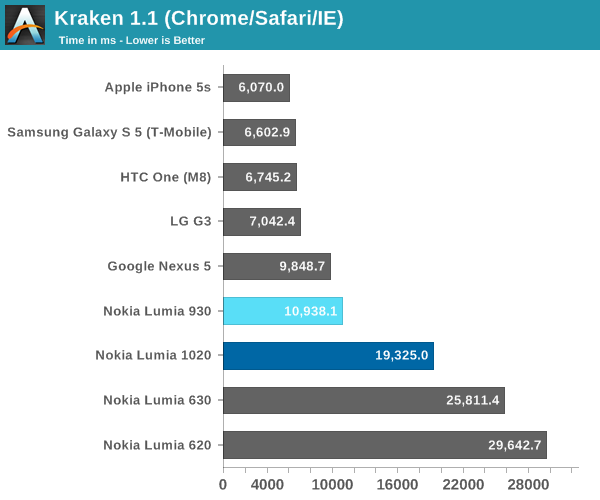
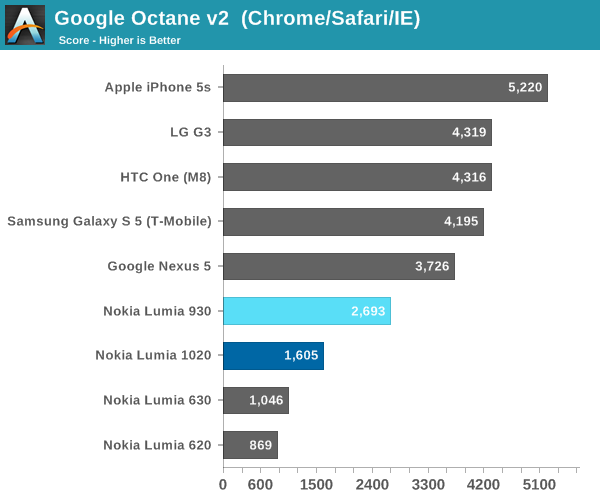
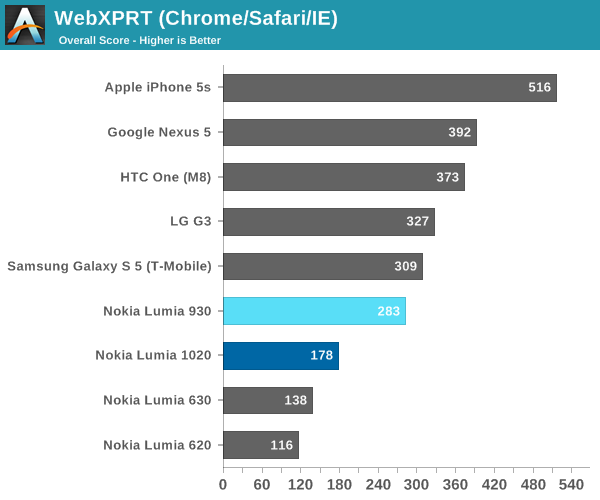
Sunspider has the Lumia 930 besting all but the iPhone 5s. Historically Internet Explorer has always done well at Sunspider though, and version 11 continues that trend. Unfortunately this benchmark has been optimized for by all companies. Moving up to more complex Javascript, we can see the difference with IE 11 compared to other browsers. The 930 falls behind the Google Nexus 5 which shares the same SoC, and it is well behind the Snapdragon 801 equipped phones. However the 930 scores almost half of the 1020 which is a great generational leap. A similar situation occurs on Google Octane, with the 930 behind the Nexus 5, but well ahead of last year’s Lumia devices. WebXPRT scores show the same trend. The Snapdragon 800 transforms Windows Phone into a contender. Javascript performance of IE 11 still is not as good as Chrome or Safari, but it is at least getting close with the latest version of the browser.
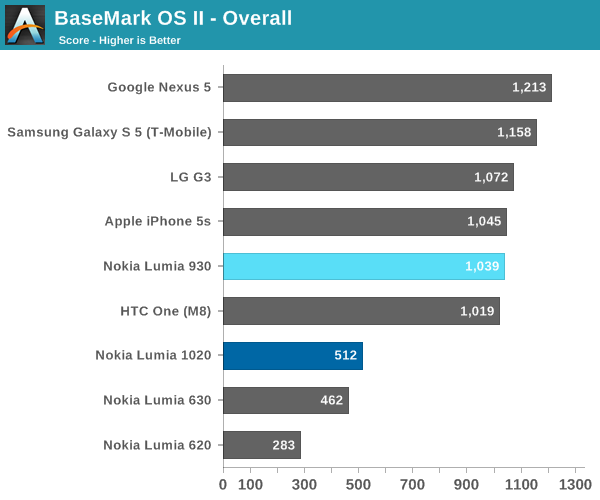
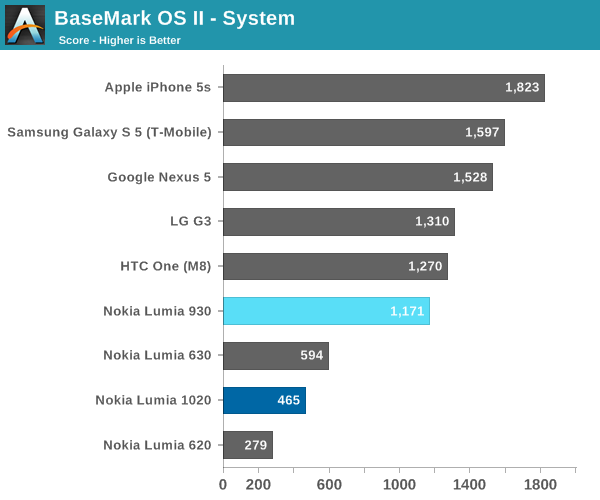
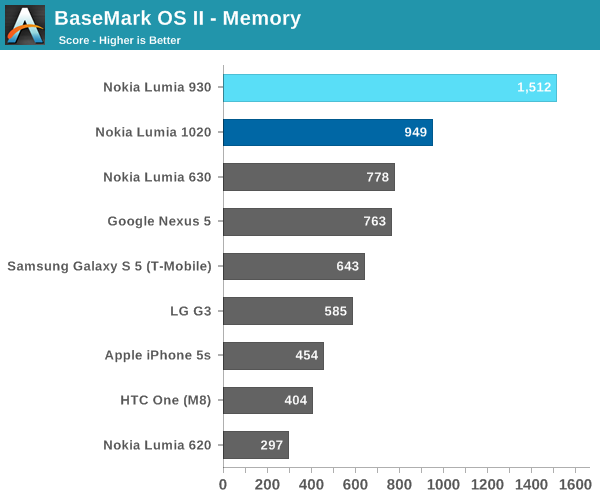
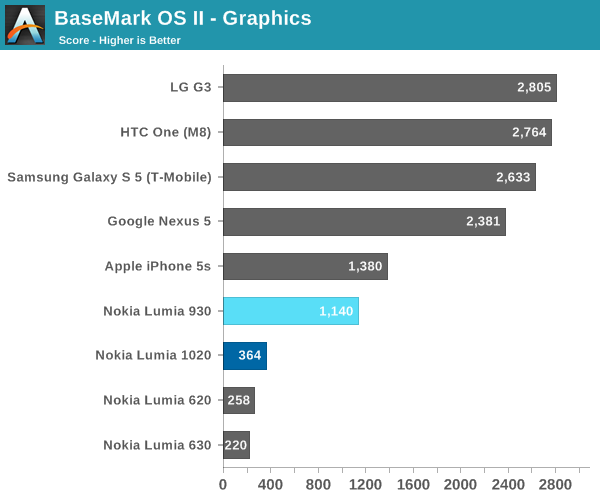
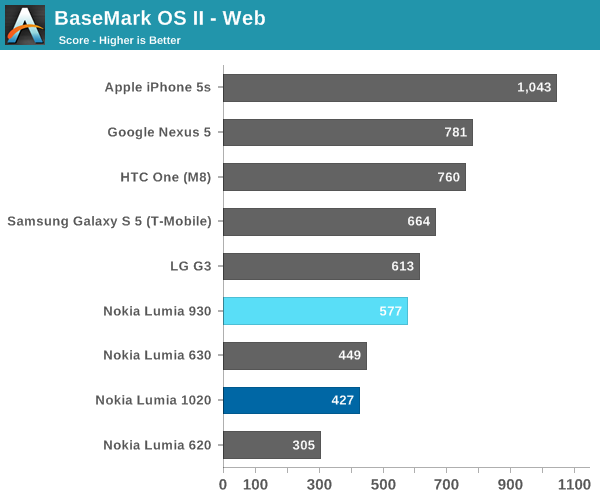
BaseMark runs as a native application, and therefore is not handicapped by the Javascript engine of the browser. Here the 930 performs well, with a score right around the same score as the iPhone 5s. Performance compared to the dual-core Krait 200 of the Lumia 1020 is once again pretty much doubled. Looking at the rest of the BaseMark scores, it becomes very clear how much of an improvement the 930 is over previous Windows Phones with MSM8960.
Graphics Performance
For GPU comparisons, we would normally turn to RightWare’s Basemark X 1.1, however a bug in the current version prevents it from running on the Lumia 1520 and Lumia 930. I have contacted them, and they have promised to look into it. If a patch is released, I will re-run the tests and update Bench. We do have access to GFXBench though, so let us see how the 930 performs.


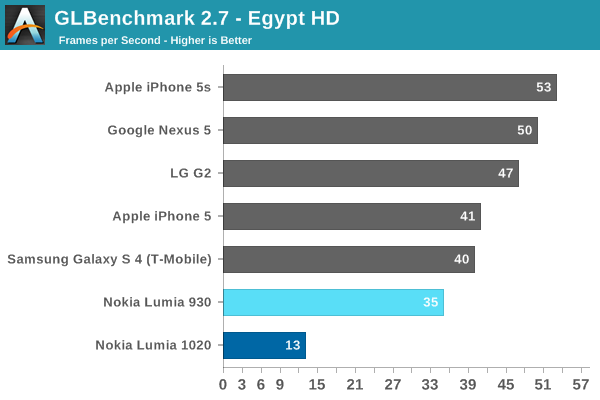
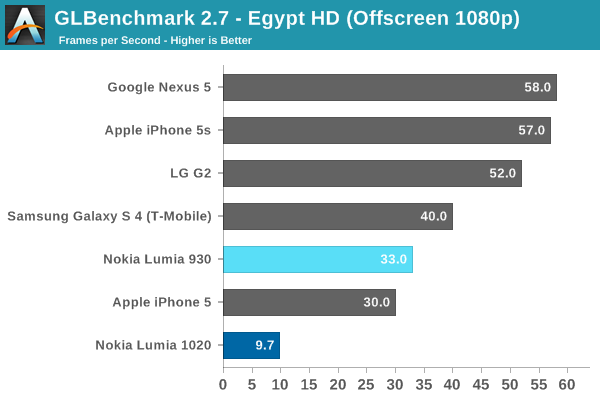
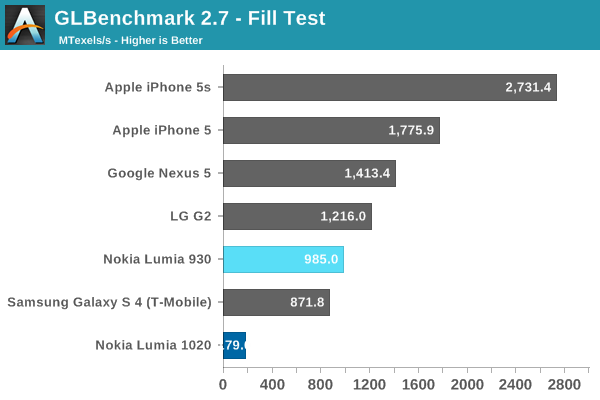
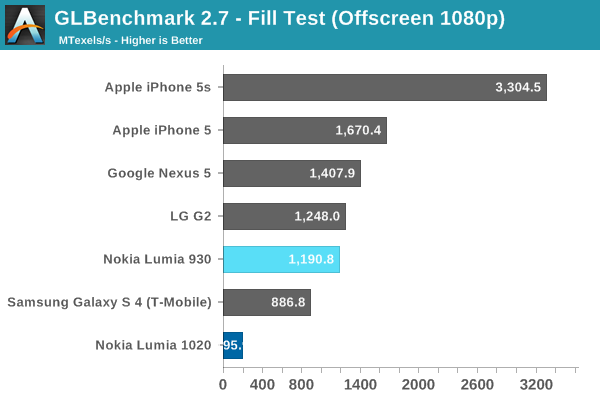


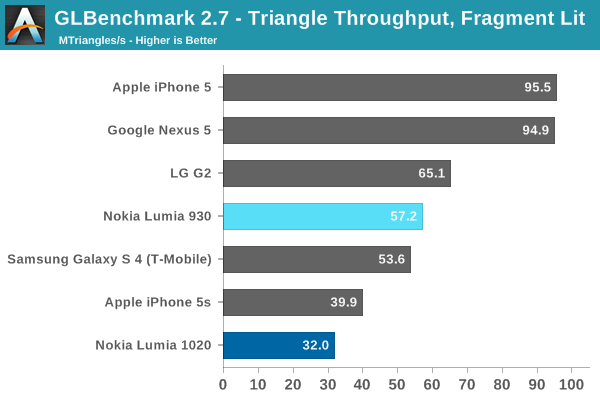
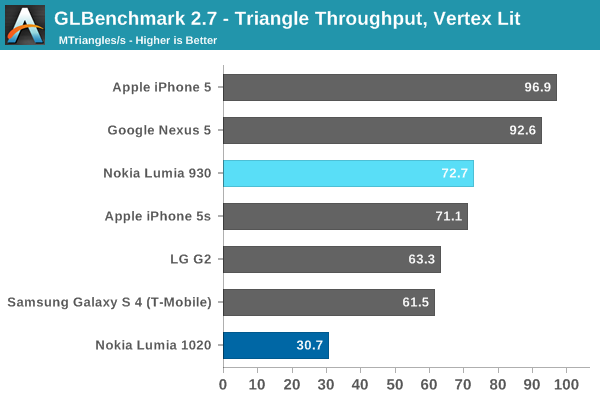

Version 2.7 of the benchmark is the current one for Windows Phone, with 3.0 listed as coming soon, however we can still get a glimpse at the huge performance leap from the last generation. While still not as quick through the benchmarks as Android and iOS, it is at least in the same room as them now.
Storage
Windows Phone does not support our storage benchmarking apps, and current ones in the store are either wildly inaccurate, or just provide abstract results. For this reason, we are going to create our own, but it is not ready yet. NAND performance was not tested on this device.
Performance Summary
One thing that Anand has harped on with regards to Windows Phone is that it is often on a much older SoC than competitive Android phones. This delta in performance is difficult to turn a blind eye to, even for supporters of the platform. With the 930 and Icon counterpart, Nokia has launched a phone which was on the most current SoC at the time of launch in February, which is a big step forward for Windows Phone performance. With the recent release of the HTC One (M8) for Windows, the platform now has the same SoC as most other flagship Android devices. That is a much bigger deal than many realize. The performance of Windows Phone has always been good on low end hardware, at least as far as the actual OS and animations, but in-app performance could suffer. The Lumia 930 is a breath of fresh air to Windows Phone and this one change alone is quite startling when compared to older devices.










115 Comments
View All Comments
milroy - Tuesday, September 9, 2014 - link
"The power button placement is certainly in the right location when compared to a phone with the power button on the top which gets awkward to use especially on a larger phone such as this."This is actually one of my main gripes with Lumia designs. The power button is so easy to access it is difficult to grip the phone without accidentally activating it. I have inadvertently turned my phone off countless times. With the current design you have to be very careful how you hold it by the sides Otherwise you need to hold it glass to back.
I’ve had the 925 and now the 1520 and both have been excellent.
siberstorm - Tuesday, September 9, 2014 - link
It would be great if you added some sort of camera consistency benchmark for future reviews. It's something most reviewers don't do. Actually I don't think I've ever seen it before. Take a dozen pictures of the same scene back to back. Mark off the ones that you consider "good" and give the percentage. Also do the same test when changing scenes quickly. The biggest reason why people like the iPhone's camera is because of its consistency. Nokia's camera's are technically better, but most people aren't looking for max potential. They want the first shot to be the only shot. This is also a problem for camera's that use their inbuilt OIS too liberally. The shutter speed is too slow and a moving subject, which is often the case, will just end up a blur. A noisy shot is much better than a smeared blurry shot.croc123 - Tuesday, September 9, 2014 - link
The more I read about the newer phones with good-ish cameras, the more I am tempted to get a new Nokia 808... While I still can. (Maybe two.)saliti - Tuesday, September 9, 2014 - link
The battery life test of Anandtech is horrible and not representative of real life battery life. I don't even use it as reference. GSMArena's battery life test is more balanced.leopard_jumps - Tuesday, September 9, 2014 - link
Shoot a video with passing cars (i.e. fast moving objects) , go to some flowers , buildings . We need to know the quality of the video abilities .boostern - Tuesday, September 9, 2014 - link
Sorry but this is one of the worst review ever made on anandtech.I really hope that is not the course that anandtech will take with the departure of Anand, because even a week ago a page like that of WiFi tests would be never been published.
boostern - Tuesday, September 9, 2014 - link
The more I read this review the more i found it flawed.Even in the battery life pace I see flaws, the subjective comments at the end where you say that in your tipical day the battery life was OK, what does it mean? How is your tipical day? What kind of activities you do in your tipical day?
Finally, there is too few data in this review compared to the Anandtech's standard...and too few comments on data outcomings.
Brett I don't want to attack you, but please read carefully one of the review made by Anand, Brian or even Joshua...
Brett Howse - Tuesday, September 9, 2014 - link
Hi Boostern,First off, I don't take it as an attack. Our readers demand a high level from us which is fantastic. If we don't meet that then we need to get better. Let me address a couple of your points:
The Wi-Fi was clearly a mistake. Without an ac router (which I am working on obtaining now) my options were test 802.11n, or not test. I chose to test n because I'd say the vast majority of people have n anyway, so they aren't going to see the huge speeds from ac. Clearly that was an error, and may people have pointed it out. In the future, I'll likely do both n and ac testing.
As for the battery life, our battery life test is really a worst case for this phone. I had to make the point that even though in the chart it shows < 6 hours, the average person on an average day is not going to need to charge the phone in 6 hours. The white backgrounds really hurt this AMOLED generation. My typical day and your typical day are not the same of course, which is why we can't test a "typical day". Perhaps we can look at doing some sort of different battery life testing and it is something we can discuss internally.
Also, not all of the benchmarking tools we use on other platforms are available on Windows Phone. It's just a reality of 3.5% market share and two dominant players in front. We are working on our own tools, but they take time and they are not available yet.
As for the comments on data, Anand had 17 years of experience and this is my second phone review, so I'll try better next time.
Thanks for reading - we all do appreciate the readers of the site. We know you expect the best and if we don't deliver it, then you have the right to ask for better.
boostern - Tuesday, September 9, 2014 - link
Thank you for the response.Regarding the battery life page in the article, I think you should also take into account the differences in Snap 800 vs Snap 801 and the inherently power differences of these two SoCs. If you compare the 930 with other phones you should also explain the differences in the results, the majority of phones you compare against the 930 are based on Snap 801 platform that brings some optimizations in power comsumption. Nonetheless you should also compare the 930 with phones based on the same platform (for example the Nexus 5) and point out that the optimization job done made by Nokia was bad and is not the state of the art. The bad result are not only due to the display adopted (surely this is a reason), but also these results comes from the adoption of the Snap 800 and the not so good job in the optimization. Another advice: are the good result obtained in Basemark battery life a result of the worse performance obtained in this test VS the competitors? As Anand and Brian showed us in the recently past this could be an explanation of the results, in that the CPU stays in lower states for a longer amount of time. Take it only as an advice ;)
snoozemode - Tuesday, September 9, 2014 - link
Also, why not use a EU -> US wall plug converter so that you could use the included 1.5A charger? Now the battery charging time is irrelevant.